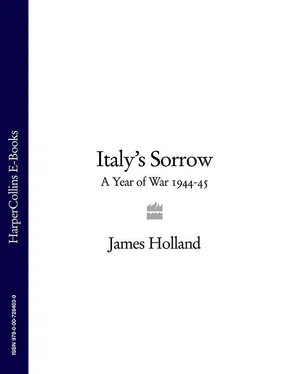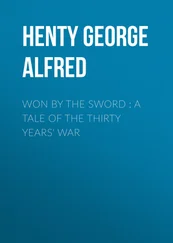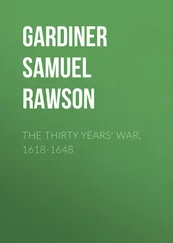1 ...8 9 10 12 13 14 ...17 General Clark had taken his share of the blame, but within a few days it became apparent that the American-led operation at Anzio, Operation SHINGLE, had also fallen short of its aims. Neither the Rapido disaster nor the setback at Anzio had been entirely Clark’s fault and both operations had been executed because of pressure higher up the chain of command. But an army commander lives and dies by his successes, and by the spring of 1944 – on the battlefield at any rate – these had been all too few. Clark was unaware that his position was under threat and that discussions had taken place about whether to remove him, but he nonetheless keenly felt the frustrations of his comparative lack of success.
Mark Clark – or ‘Wayne’ as friends knew him – had just turned forty-eight at the start of May. Standing six foot three inches tall, he was lean and muscular, his hair still dark, and despite a prominently hawkish nose, he was a youthful-looking and handsome three-star general who towered over most of his subordinates and superiors alike. One of the few American commanders who had seen action in the last war, he had led a battalion in France in 1917, until wounded when a shell had exploded nearby. He spent the rest of the war as a captain carrying out staff duties. It was a rank he kept for sixteen years, sitting out the post-war doldrums with mounting impatience.
In 1933 his fortunes had finally begun to change, with promotion followed by time spent at both the US Command and General Staff College and the Army War College, so marking him out for future high command. By the summer of 1937 he had joined the 3rd Division, where he renewed his friendship with his old West Point friend, Dwight D. Eisenhower. By 1940, he was a lieutenant-colonel and was appointed chief of staff to General Lesley McNair, the man commanded to expand, train, and reorganise the US Army ready for war. Clark immediately showed his exceptional aptitude for planning and organisation, demonstrating great resources of energy, intelligence, enthusiasm, and an ability to get things done, and done fast.
Catching the eye of General Marshall, the US Chief of Staff, Clark was sent to Britain in 1942 along with Eisenhower to arrange for the reception and training of American troops and to begin preparations for the invasion of Continental Europe. When immediate Allied plans were redirected towards an invasion of northwest Africa, Eisenhower was made Commander-in-Chief with Clark as his deputy. As head of planning for Operation TORCH, Clark deservedly won a great deal of credit for pulling off what was the largest seaborne invasion the world had ever known. It was also no small thanks to Clark and his pre-invasion discussions with Vichy French commanders that the resulting landing was a comparative walkover.
But however much Clark had proved himself as a planner and diplomat, he desperately wanted the chance for operational command but, as Eisenhower’s official deputy, he knew he was in danger of spending the rest of the war as a desk man. Consequently, he began to badger his chief for his own command until he was eventually appointed commander of the newly created US Fifth Army, the first American army headquarters to be formed overseas. Although for the first few months it was little more than a training organisation, it was then that he began to develop a deep affection for Fifth Army, a force that he nurtured and considered his own. Together, he believed, they were destined to achieve great victories.
Not until the invasion of Italy was Clark finally given the chance he so craved, of leading his men in battle. Given the task of planning the main Allied landings at Salerno, VI Corps from his Fifth Army duly landed on 9 September 1943. It was almost a massive failure. Heavily contested by Kesselring’s AOK 10, it had been a far more bitter fight than either the North African or Sicily landings. Clark, however, had showed resolve and courage, quickly getting himself onto the beachhead and taking firm and decisive command. At one point, during the second and most threatening German counterattack, he took personal charge of an anti-tank unit and turned back eighteen German tanks at almost point-blank range. The Allies regained their footing, a bridgehead was firmly established, and as Axis forces withdrew north towards the defences of the Gustav Line, Clark and his Fifth Army quickly took Naples, a key port on the route to Rome.
Despite this success, however, Clark suffered the mutterings of some. At the height of Salerno, with defeat a distinct possibility, Clark realised he had made no provision for an evacuation should the worst occur. Quickly trying to rectify this, he ordered his staff to make the necessary plans for a withdrawal. Although purely a contingency plan, news of these orders spread; to some, this was not seen as Clark’s pragmatism shining through, but rather a sign that he had momentarily lost his nerve.
In fact, at Salerno and in the fighting in Italy since the Allied invasion, Clark had proved himself an extremely able battlefield commander. He possessed a thorough understanding of modern all-arms tactics, an ability to grasp and see the bigger strategic overview, and was not afraid of taking difficult decisions or the rap if things did not go according to plan. However, many found him overly blunt, arrogant even; he could be prickly – and brusque and heavy handed with his subordinates. He was the boss – and no one was allowed to forget it. If that made him unpopular to some, well to hell with it; winning battles and the war was what counted, not worrying about telling people some harsh home truths. Again, in many respects, there was nothing wrong with this approach, but unfortunately Clark also suffered from a deep-rooted hang-up that many of his fellow commanders, whether Alexander or Leese, or the British corps commanders attached to his Fifth Army, had considerably more battlefield experience than he and he suspected that they looked down on him because of this. There is no evidence that anyone regarded this as a defect at all, but it niggled him considerably and made him far too quick to see the decisions of Alexander and others as an attempt to undermine him, his authority, and to belittle the efforts of his Fifth Army.
Just six days earlier, on 5 May, this paranoia had come to the fore when Alexander made a visit to the Anzio bridgehead, from where the US-led VI Corps was to make its break-out once the southern front had been sufficiently broken in the forthcoming battle. There, Alexander had spoken with Major-General Lucian Truscott, the VI Corps commander. After hearing Truscott’s plans, Alexander suggested he should be concentrating on only one course of action, namely to spearhead north-eastwards towards Cisterna, Cori and Valmontone, as had been previously agreed with Clark and all concerned. Truscott then informed Clark of this conversation. Outraged, Clark rang Alexander’s headquarters and demanded to speak with the British commander. ‘I told Alexander,’ Clark wrote in his diary, ‘that I resented deeply his issuing any instructions to my subordinates.’ Alexander, by now used to Clark’s occasional fits of over-sensitiveness, assured him he had not intended to undermine his authority in any way, and that he had merely made the point lightly in the course of his conversation with Truscott, gently reminding Clark that he was only telling Truscott what had already been agreed. It seemed to be what the American wanted to hear. ‘This is a small matter,’ Clark noted later, his honour sated and his feathers smoothed once more, ‘but it is well that I let him know now, as I have in the past, that he will deal directly with me and never with a subordinate.’4
However, on the eve of battle – 11 May – that day of days, Clark was playing the part of army commander perfectly. It is typical of him that he should have chosen that morning to address the men of the 36th Texas Division – the men who blamed him above all for the Bloody Rapido – looking them in the eye and stirring them for the battle to come, a battle in which yet more of them would lose their lives.
Читать дальше











